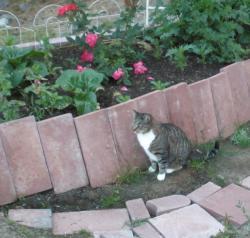One thing about lining the bed fully with plastic: like a planter, it still needs drain holes. Residual salt (and rare, heavy rains or over-watering) needs a way to flow out of the bed. Over the years it will accumulate even if you don't add much chemical fertilizer.
If the plastic 'floor' slopes very gradually to one edge or one corner, that low point needs some holes so that excess water will flow out (carrying potential salt buildup with it). If the "floor" is level you need at least some holes or gaps so that exess water can escape.
I was impressed that one of the U. AZ leaflets mentioned salt accumulation at least in passing. Probably you won't need to worry about that for years unless your soil provider loaded it manure that happened to be extra-salty.
If there were no plastic floor, your bed's soil would press against the subsoil, establishing a wide fast wicking path, or capillary connection. Then any water that you add will flow down pretty quickly until your bed is around as dry as soil underneath and around the bed.
The plastic floor breaks that connection so that "most" water will stay in the bed.
But you can't allow "excess" water to stay in the bed. That would displace the air from the soil. The "excess" water is what fills large gaps, voids and and air channels in soil (say any gap larger than 1/2 mm). When those voids are filled with air, gas diffusion is fast and easy. Roots and soil life can get rid of CO2 and take in the oxygen they need.
When gaps are filled with water ("waterlogged soil"), Oxygen can not diffuse in fast enough Roots would literally drown and rot (like most roots do in waterlogged mud).
(Digression: If you have a pot where the plant's roots only fill the top part of the soil, but the bottom inch or so is wet and without roots, probably that was"perched" water making the bottom of the pot anaerobic. "Perched" water is in-between capillary water and freely-draining water, and I don't fully understand why it exists.)
The solution for all garden soils and potting soils is to be "open" enough, and drain fast enough, for excess water (non-capillary water) to drain down via gravity and capillary attraction. Pots and planters and raised beds need holes so that the excess water can escape. Good drainage assures good aeration.
Since you probably have very few heavy rains, you don't need lots of big holes. But imagine running a sprinkler or irrigation system or having rain on your bed while the plastic is down, but the soil is not yet in it. All the water should be able to run out in, say, 15-20 minutes after a heavy watering.
Once the soil is in, if you water the bed heavily when it is pretty dry, 80-95% of the water will be drawn right into the soil and
held firmly by capillary attraction in the SMALL gaps between soil particles (say 0.1 mm).
The other 5-20% of the heavy watering will remain in the larger gaps where it is more free to react to gravity by flowing down, and eventually out of the bed.
The capillary water being held in the SMALL gaps is your soil's healthy water-retaining-capacity. It doesn't block air from diffusing in. It does allow the plants to drink gradually what they need, and sustains soil microbes, worms and other necessary soil life.
That capillary water would only drain away if the plastic floor were missing or was 20% holes. Then, the surrounding soil would have a good capillary connection to your bed. Then,
not only gravity but also the capillary attraction of your whole desert would "suck" even the capillary water out of your bed, competing with your plants for the scarcest resource.
To conserve water, you might water 20% less than I described above, and never need holes in the floor until you need to flush away salt build up after a few years, or you get a rare rainstorm.
Sorry to be so long-winded. but after i encouraged you to put down a plastic floor, I didn't want you to get what I got the first time I tried to prepare a slope for a raised bed in the rainy Pacific NorthWet. . I remembered that "water flows downhill", but I forgot that once it got there, it STAYED there!





